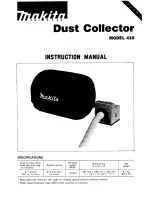
25
Donaldson Company, Inc.
Operation
Start-Up
1. Start the positive-displacement cleaning blower and
check for proper blower rotation.
2. Turn power to timer and solenoid ON.
3. Check solenoid and diaphragm valve operation.
4. Adjust the timer to allow the cleaning system
pressure to rise to 7.5-psig between pulses. Too
short of an OFF time results in inadequate cleaning
pressure; too long of an OFF time will result in the
pressure relief valve discharging cleaning air.
5. Close the isolation petcock between the positive-
displacement blower and the gauge.
6. Start the system as shown in Start-Up Sequence.
7. Adjust fan for proper airflow with the volume control
damper, if equipped.
8. Measure initial pressure drop across the tube sheet
and filter bags during normal process operation
with dust actively generated. Pressure drop will
gradually rise until an equilibrium pressure drop is
achieved, generally 3 to 4 “wg for seasoned filters,
although anything between 1 to 6 “wg is considered
normal.
Start-Up/Shut-Down Sequences
The recommended sequences for motor start-up and
shut-down are outlined below. These sequences assure
minimal material build-up in the hopper of the collector.
Not following these sequences
can adversely impact the life
of the filters and may result in equipment
damage.
Start-Up Sequence
1. Pneumatic conveyor or transfer blower, if equipped.
2. Rotary airlock and screw conveyor - start
simultaneously.
3. Manifold drive and pulse timer.
4. Positive-displacement cleaning blower.
5. Main blower.
Shut-Down Sequence
1. Main blower.
2. Positive-displacement cleaning blower.
3. Manifold drive and pulse timer.
4. Rotary airlock and screw conveyor - shut-down
simultaneously.
5. Pneumatic conveyor or transfer blower, if equipped.
















































